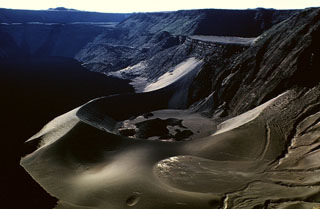Report on Cerro Azul (Ecuador) — January 1979
Scientific Event Alert Network Bulletin, vol. 4, no. 1 (January 1979)
Managing Editor: David Squires.
Cerro Azul (Ecuador) Eruption underway on E flank
Please cite this report as:
Global Volcanism Program, 1979. Report on Cerro Azul (Ecuador) (Squires, D., ed.). Scientific Event Alert Network Bulletin, 4:1. Smithsonian Institution. https://doi.org/10.5479/si.GVP.SEAN197901-353060
Cerro Azul
Ecuador
0.92°S, 91.408°W; summit elev. 1640 m
All times are local (unless otherwise noted)
At 2000 on 2 February red glow was sighted from a fishing boat E of Isla Isabela. The source has since been confirmed as two small craters on the E flank of Cerro Azul. Red glow was seen from CDRS, [110] km to the E, at 0100 on 5 February. By this date, two groups were investigating the eruption on foot and a more detailed report will be included next month.
Geological Summary. Located at the SW tip of the J-shaped Isabela Island, Cerro Azul contains a steep-walled 4 x 5 km nested summit caldera complex that is one of the smallest diameter, but at 650 m one of the deepest in the Galápagos Islands. The shield volcano is the second highest of the archipelago. A conspicuous bench occupies the SW and west sides of the caldera, which formed during several episodes of collapse. Youthful lava flows cover much of the caldera floor, which has also contained ephemeral lakes. A prominent tuff cone located at the ENE side of the caldera is evidence of episodic hydrovolcanism. Numerous spatter cones dot the western flanks. Fresh-looking lava flows, many erupted from circumferential fissures, descend the NE and NW flanks. Historical eruptions date back only to 1932, but Cerro Azul has been one of the most active Galápagos volcanoes since that time. Solfataric activity continues within the caldera.
Information Contacts: H. Hoeck, CDRS, Galápagos.

